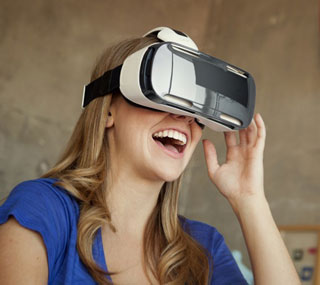
Vol. XVIII, No. 8, September 2018
- Editor's corner
- A snapshot at out-of-home 'entertainments' True Reality
- College educated women delaying motherhood
- It's time to kill the FEC Industry (name)
- American's pizza obsession
- Holey Moley, it's a mini golf cocktail bar
- What's happening with at-home and mobile screen video game play?
- Is your center Snapchat geofenced?
- Time saved, or time well spent?
- Decline in births now equals the drop during the Great Depression
- What matters, income or education?
A snapshot at out-of-home 'entertainments' True Reality
by Kevin Williams, guest author
The phrases' Virtual Reality and Augmented Reality seems to be the zeitgeist for much of the reporting in new developments in the out-of-home entertainment and community-based leisure venues (CLVs) scene. Industry specialist Kevin Williams of consultancy KWP looks at the real implications and opportunities that are shaping the thinking in this field.
Is tech better than real?
The argument of whether the VR technology offers a better ROI let alone a great experience compared to the more traditional amusement and leisure fixture has been raised many times, especially when faced with considerable “sticker shock” when investing in this new and evolving technology. But we need to understand that Interactive Out-of-Home entertainment (OOH) is much more than just the latest gaming tech but is a wholesale new approach to the entertainment experience.
The main new investment is in the “guest experience,” rather than just deploying entertainment in a space with minimal theming – the new OOH environment looks to offer a socially inclusive space that appeals to the “millennially-minded” guest looking for a social handout (#SHO) that engages on a level not found from their “in-home” entertainment offerings. Not all this entertainment has to be “tech” but can be also an application of the experience offered that is compelling, socially inclusive and most importantly encourages a repeat visitation.
The next element of the new entertainment offering is a “new way to pay.” Moving away from a fixed and inflexible pricing model, the new entertainment experience has to allow for a value for money proposition that is driven by “invisible” technological application – be this the latest contactless payment methodology, or the employment of brand new wearable payment systems that go far beyond the restrictions of traditional tokens or swipe card. The CRM (Customer Relationship Management) is driven by offering an engaging experience that is supported, and not forced upon, payment model.
Regarding VR, this is just one of the many arrows in the quiver of developers creating compelling entertainment environments – be they based around retail, hospitality, or the more familiar entertainment experience.
Will VR have legs?
The current technology being deployed in the sector comes in at least three flavours (VR arcade, LBE VR, and VR attractions), of what our consultancy has evaluated – this technology is still at a level of infancy that leaves it vulnerable to the whims of the market and shows a level of engagement and robustness that seems wanting if it hopes to become as established as bowling, ziplines and escape rooms as a “go-to” entertainment offering.
Inevitably we are going to be bombarded with stories of epic collapses in the coming months surrounding previously hyperbolic new start-ups in this sector. As one that has lived through a previous boom and bust in the deployment of VR into the commercial entertainment sector this seems to be a textbook repeat of much of the failings. But, there is a glimmer of hope that this time round the technology has achieved a greater traction. And once the dust settles a real new branch of the sector could emerge.

We seem to be at a point where there is a great interest from a target audience for immersive entertainment, though many are still undecided that they want to immerse themselves by having to wear cumbersome headgear. We are seeing more traditional means to immerse an audience within a unique environment with “Secret Cinema”, “Immersive Theater” and even the development of new “Immersive Hotel” experiences (such as with the soon to be launched Disney Star Wars Hotel). All these offerings depend on a hiding of the technology, rather than a dependence wholly on it.
Looking at projects such as Twobit Circus new start-up concept, to survive the first phase of this technologies adaption we seem to be seeing a mixing of proven hospitality and entertainment engagement, with new technology offering a new and compelling experience to be added to the mix. Those venues and concepts that have wholly focused on the “VR-tech” are finding that this is unsustainable, and that any project that neglects to incorporate a repeat visitation engagement with their audience is aiming for failure.
Where is the future?
As a specialist in this sector, immersive entertainment seems to be at a point of offering a brand-new future for the social entertainment experience. As stated previously, the technology is only a small part of the adaptation, but it is still an element that will need to evolve to be able to offer the broadest entertainment offering and be able to be deployed effectively into the future community-based leisure venues (CLVs).
The hyperbole is now running down and we start to see that Virtual Reality and Augment Reality are two sides of the same coin, either referred to as Mixed Reality of more commonly XR. This XR looks not just at wearable head-mounted display systems as seen with AR and VR applications (that are now converging), but also the creation of digital displays so immersive that they pull the user into the virtual experience, most familiar seen with the latest Projection Mapping applications.
But on the periphery of entertainment experience investment, we are seeing the development of Machine Learning in our sector – allowing for a great sophistication and customisation of the guest experience. Using sophisticated tracking technology, the guests experience can become an interactive adventure, where they shape the outcome, and even can take part in games accruing scores and finding secrets that generate an interest to repeat their experience.
With this in mind, it leads me to the most interesting aspect of this brave new world, and it is not just the technology, but the type of experience that we will be exploring in the very near future. The traditional “passive” experience of watching and not engaging and even changing the narrative will be a thing of the past – the modern audience is all for “agency” and will become less receptive to entertainment set on rails. While at the same time where “gamification” (adding a game element to mundane activities) could totally change the way we experience our entertainment.
The one fundamental is however, the more things change the more they stay the same – and those that forget the core principles of what makes a fun and engaging entertainment experience (be it in a hospitality, leisure or even educational environment), will find that no amount of “tech” will save them from failure!
About the Author

Kevin Williams has an extensive background in the development and sales of the latest amusement and attraction applications and technologies. The UK-born specialist in the pay-to-play scene; is well-known and respected through his consultancy KWP; and as a prolific writer and presenter (along with his own news service The Stinger Report), covering the emergence of the new entertainment market. Kevin has co-authored a book covering the sector called ‘The Out-of-Home Interactive Entertainment Frontier' (published by Routledge), is feverishly working on the sequel to the book to be published in 2019. He is also the founding chairman of the DNA Association, focuses on the digital Out-of-Home interactive entertainment sector. Kevin can be reached at kwp@thestingerreport.com.
Vol. XVIII, No. 8, September 2018
- Editor's corner
- A snapshot at out-of-home 'entertainments' True Reality
- College educated women delaying motherhood
- It's time to kill the FEC Industry (name)
- American's pizza obsession
- Holey Moley, it's a mini golf cocktail bar
- What's happening with at-home and mobile screen video game play?
- Is your center Snapchat geofenced?
- Time saved, or time well spent?
- Decline in births now equals the drop during the Great Depression
- What matters, income or education?


